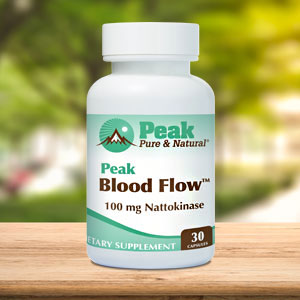Get Easy Health Digest™ in your inbox and don’t miss a thing when you subscribe today. Plus, get the free bonus report, Mother Nature’s Tips, Tricks and Remedies for Cholesterol, Blood Pressure & Blood Sugar as my way of saying welcome to the community!
4 symptoms of a blood clot you should never ignore

But blood clots can be deadly for any of us.
Strokes, heart attacks and organ failure can result from a clot that gets lodged in a blood vessel deep within the body without our knowledge.
Lucky for us there are warning signs that a blood clot may be stuck somewhere in your circulatory system. And, there are ways most of us can prevent them from forming in the first place.
Normal blood clotting is not dangerous…
Clotting of the blood is a normal bodily function. When things go as planned, blood clots any time there is an injury to a blood vessel, such as when you cut yourself. Tiny bits in your blood called platelets get “turned on” when an artery or vein is damaged. They stick to the walls of the blood vessel, and to each other, forming a plug that stops blood from leaking out.
Special proteins keep the clot from spreading farther than it needs to. And as the damaged tissue heals and the clot isn’t needed anymore, it dissolves back into the blood.
Sometimes, though, the clotting process goes off the rails and dangerous complications can occur. Clots can also fail to dissolve after an injury has healed. Or a clot can form without an injury…
Clotting gone bad
A blood clot can form in any blood vessel in your body. If it breaks loose and travels through the blood, it can end up in the lungs, heart, brain or other organs and disrupt the normal flow of blood to those organs.
This is when a heart attack or stroke can occur. But there are other dangerous complications of a clot breaking loose…
A pulmonary embolism is a blood clot that lodges in a pulmonary artery in one of the lungs. It can result in low oxygen levels and damage to the heart, lungs and other organs.
Deep vein thrombosis (DVT) happens when a clot forms deep within a vein in the arm or leg. If the clot breaks off and travels to the lungs, serious complications could occur.
Kidney failure is caused by blood clots in the kidneys. Fluids and waste build up, which can also cause high blood pressure.
Who is at risk for clotting?
You are at higher than average risk of a blood clot if:
- You use birth control pills or hormone therapy
- You are obese
- You smoke
- You have diabetes
- You’re over the age of 60
- You have a sedentary lifestyle, or you’re resting at home after surgery
- You’ve had orthopedic surgery
- You’re traveling for a long time in a plane, car or train, and you’re not able to move around much
- You have certain blood disorders, such as Factor V Leiden, that make you more prone to clotting
- You have the autoimmune disorder lupus
- You have cancer
What are the symptoms of a blood clot?
The location of a clot will determine where in the body symptoms are experienced. But there are four major symptoms you should never ignore, especially if they come on suddenly and with no other explanation.
- Swelling. When a clot slows or stops the flow of blood, the blood can build up in an artery or vein and make it swell. If this happens in the lower leg, it can be a sign of deep vein thrombosis.
- Skin color. A clot in your arm or leg may turn the skin bluish or reddish, and it may stay that way for days because blood vessels have been damaged as the clot passes through them. A pulmonary embolism in the lung can make your skin pale, bluish and clammy because you’re not getting enough oxygen.
- Pain. Sudden, intense pain should never be ignored. When it’s chest pain, it could be a sign of a pulmonary embolism or a heart attack caused by an arterial blockage. If this is the case, you might also feel pain in your left arm.
- Trouble breathing. Never ignore this. Seek medical help right away. You could have a clot in your lung or heart. If you do, your heart may also race, or you may feel faint or sweaty.
How to reduce the risk of blood clots
Talk to your doctor about your risks. If you decide together that your risk of clotting is high, your doctor may recommend blood thinners, particularly if you’re going on a trip that involves a long flight (less likely now with the pandemic here, of course, but those trips will happen again).
Practice healthy habits. Stay physically active. Don’t smoke, or try to cut back or quit.
Get up after surgery. Work with your healthcare team to get back on our feet as soon as possible after any surgery. The longer you stay sedentary, the higher your risk for clotting.
Don’t sit for too long. If you work at a sedentary job, get up and walk every hour and keep your feet elevated while you sit.
Watch your blood pressure. Keep hypertension, diabetes and other chronic conditions under control.
There are numerous safe and natural ways to decrease your risk of blood clots including…
• A nutrient that acts as a natural blood thinner…
• The bypass-in-a-pill that sweeps dangerous plaque from your arteries without surgery…
• The sugar cane cure for high cholesterol and high blood pressure that produces amazing results…
• The “plain Jane” vegetable extract that can lower your risk of high triglycerides by 26 percent…
• And even more natural secrets for protecting and healing your heart…
Editor’s note: There are perfectly safe and natural ways to decrease your risk of blood clots including the 25-cent vitamin, the nutrient that acts as a natural blood thinner and the powerful herb that helps clear plaque. To discover these and other secrets of long-lived hearts, click here for Hushed Up Natural Heart Cures and Common Misconceptions of Popular Heart Treatments!
Sources:
- 4 blood clot symptoms you should not ignore — Web MD
- 10 signs of a blood clot — FactyHealth
- Blood Clot Info: Know Your Risk, Recognize Symptoms, and Prevent Blood Clots — stoptheclot.org
- Blood clots – how they form and common causes — Web MD
- Symptoms and complications of blood clots — Healthline
- What are the warning signs of a blood clot? — health.usnews.com













